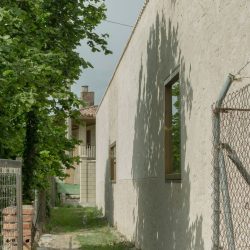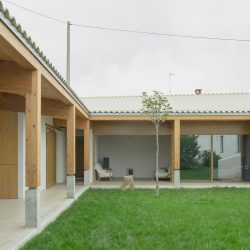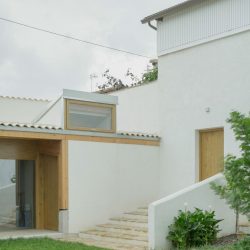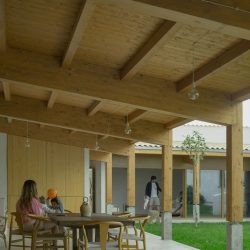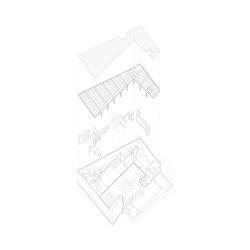
ATELIER ATLANTICO . photos: © Federico Cairoli
Located in Bañares, La Rioja, the paio for Elena answers to the need of creaing an indeterminate space that delves into the depths of the typological transformaions suffered after the COVID-19. This new place is confirmed as a constant threshold between interior and exterior. A sort of Perysilum that explores the typology of the tradiional paio house in the country, extracing from the built memory of the site a series of relaional guidelines that help to configure an interior paradise.
The exercise recognizes, first of all, the physical condiions of the plot in which it is inserted. This new space is located on the inner edge of the consolidated urban area of the populaion and, therefore, must create an architecture that builds a limit and a wall. With this premise we remember the client’s first intenions, who dreamed of an interior paradise rooted in the memory of her village and her grandfather’s grocery.
These condiions, together with the physical characterisics of the place, offered us a series of operaions to carry out. The first of the strategies was to consolidate the edge and to clarify the center. This space subtracted from the total mass of the plot responds to the projecion and geometry of the exising construcion inherited from his own family, grandfather Julián’s winery. Likewise, due to the irregular geometry of the plot, it is decided that the void will be regular, establishing a hierarchy and order in the structural elements that will configure the center of that paio. Lastly, the remarked topography of “las suertes” area makes the exercise have a dual scale, establishing itself as a construcion with a friendly scale to the outside, and doubling its space when experiencing the interior.
Once the first acions have been decided, the next of the strategies will link heaven and earth. Two complementary construcion operaions are proposed. A gravid wall that belongs to a stereotomic and heavy type that emerges from the earth, and a light wooden structure, floaing on the concrete columns.
The new architecture is proposed through load-bearing walls that consolidate the program on the outer edge. On the north the access is placed, which is reached by descending a steep slope that has a flared hollow, linking the Hermitage, Church and paio. On this same wall, but facing South, two climate-protected spaces are responsible for providing shelter inside. The bathroom, kitchen and other complementary uses consolidate the construcion on the western limit, configuring a self-absorbed architecture that observes the exterior garden landscape through two openings. To the east, the exising construcion, the grocery, connects with the new space, execuing a staircase and opening a single opening to link interior and paradise. A series of recovery operaions are carried out on this construcion; The enclosure is repaired by applying rendered lime mortar and troweled without mastering, in addiion to a new mini-wave sheet that prevents the entry of water and provides a scalar sense to the whole.
The new space is built looking at the material and typological memory of its past. For this, a lime mortar mixed with sandstone powder from La Rioja is used, which offers its unique toasted tobacco color. The mortar is applied with two techniques, the first of which passes the trowel in favor of the lime. Therefore, the stone material remains underneath, showing “the good face” of the mortar, which is reminiscent of the the windows ashlars in tradiional La Rioja and Casilla architecture. The second of the techniques carried out operates in the opposite direcion. In this way, the sandstone dust settles on top, consolidaing a rough appearance that recalls the old faces of the ashlars that build holes and sockets.
The structure, carpentry and cabinets are made enirely of ¨pino radiata¨ wood from the Basque Country. Likewise, the limestone that makes up the perimeter countertops or the stone slabs of the flooring comes from La Rioja itself, so all the materials that our context has at its disposal are used. The paio for Elena aspires to build an architecture that configures a kind of physical memory of the locaion. An architecture that, using shadow as a resource, configures a typological and materially unexpected space for Bañares.
_
Team:
Author: ATELIER ATLANTICO (Mario Galiana Liras, German Muller)
Photography: Luis Asín, Federico Cairoli, Clara Larrea, Atelier Atlántico







